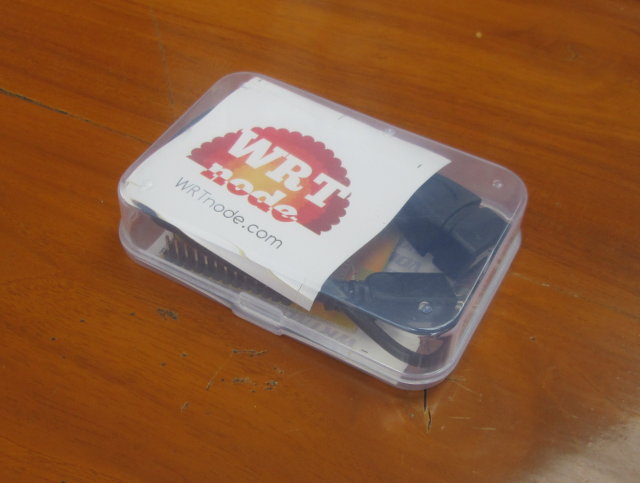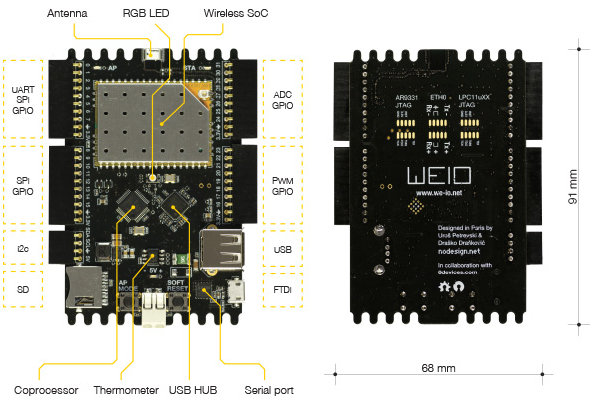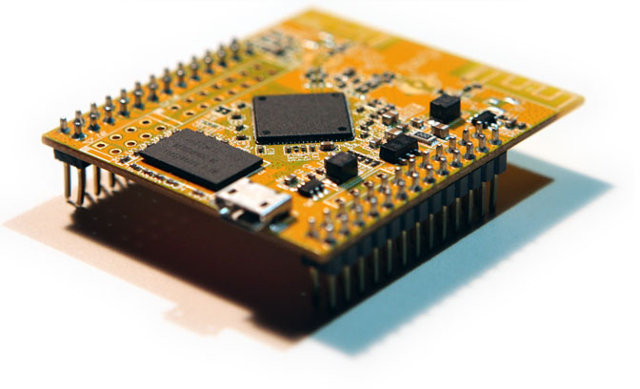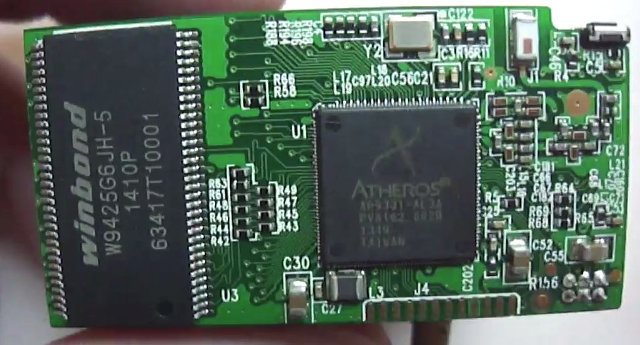Seeed Studio sent me two nice little boards that can be used for IoT development: WRTNode and LinkIt ONE. Today, I’ll show pictures of WRTNode and accessories, and go through the “starting guide“, and will test LinkIt ONE board a few days later. WRTnode Unboxing I’ve received WRTnode by Fedex, and the board is stored in a plastic box. Inside the box, you’ll find the board, a “special” USB used to power the board and as an OTG adapter, a piece of paper with useful links (Wiki), and some WRTnode stickers. Any micro USB to USB cable can be used to power the board, but this cable is useless to connect USB devices such as flash drives, webcams (OpenCV is supported), Bluetooth dongles, and so on. You could even connect a USB hub to connect multiple USB devices as shown below. I’ve also taken a picture of both sides of […]
WeIO is an Open Source Hardware IoT Board Programmable from a Web Browser (Crowdfunding)
WeIO is an open source hardware board for the Internet of things with Wi-Fi connectivity and lots of I/Os designed by nodesign, a French based startup, in collaboration of 8devices, the makers of the Carambola boards. WeIO is powered by an Atheros AR9331 SoC running OpenWRT as well as an NXP LPC MCU for faster handling of I/Os and support for analog I/Os. One interesting aspect of this board is that it can be programmed via a web browser using HTML5 or Python, and it does not rely on the Cloud to store data. WeIO hardware specifications: SoC – Atheros AR9331 MIPS 24K Wireless SoC @ 400 MHz MCU – NXP LPC11xx ARM Cortex M0 MCU for analog I/O and real-time H/W interfaces System Memory – 64 MB DDR2 Storage – 16 MB flash + micro SD slot Connectivity – 802.11 b/g/n Wi-Fi with on-board antenna (AP and STA modes), […]
$25 GL.iNet 6416A is an Hackable OpenWRT Router with Easy UART and GPIO Access
There are plenty of low cost routers supporting OpenWRT, but GL.iNet 6416A has several advantages compared to devices like TP-Link WR703N. Both are based on Atheros AR9931, but GL.iNet router has more memory and storage (64MB RAM + 16MB Flash vs 32MB RAM + 4MB Flash), two Ethernet ports instead of just one, and 6 GPIOs, the serial pins, and power signals (5V, 3.3V and GND) are all easily accessible via though holes or headers. Gl.iNet 6416A can be purchased for about $25 on DealExtreme or Amazon US, and it used to be listed on eBay, but is now out of stock. Gl/iNET 6416A specifications: Wi-Fi SoC – Atheros AR9331 MIPS processor @ 400 MHz System Memory – 64MB RAM Storage – 16MB Flash Connectivity – 2x 10/100 Mbit Ethernet ports, 802.11 b/g/n Wi-FI up to 150Mbps USB – 1x USB 2.0 port, 1x micro USB port for power Debugging […]
WRTNode is a Hacker-Friendly Open Source Hardware OpenWRT Wi-Fi Module Selling for $25
There are now some tiny and low cost ($15 to $20) Wi-Fi modules supporting OpenWRT such as VoCore and AsiaRF AWM002. However due to their small size they may not be that hacker’s friendly as they can’t have 2.54mm headers due to heir small size, and I’ve recently received AsiaRF AWM002 only to find out it not only needs 3.3V supply voltage, but also 1.8V and 1.2V. So I’d need to make my own power circuit with the required LDOs, or purchase a $20 base board to use the module. Here comes WRTnode another larger Wi-Fi module but with more usable 2.54mm headers, and based on the more powerful Mediatek MT7620N processor @ 600MHz. WRTnode hardware specifications: Processor – Mediatek MT7620N 600MHz MIPS CPU (MIPS24KEc) System Memory – 64MB DDR2 Storage – 16MB SPI flash Connectivity – Wi-Fi 2T2R 802.11n 2.4 GHz up to 300Mbps Expansion Headers – 2x with […]
Kankun KK-SP3 Wi-Fi Smart Socket Hacked, Based on Atheros AR9331, Running OpenWRT
Kankun KK-SP3 is a $20 Wi-Fi smart socket that can be controlled via iOS and Android app. But one person created a Kankun community on Google+ to try to hack the device and control it from a PC, or from outside the home network for example. Up to now, the device has been opened, found to run OpenWRT, and one the member wrote a Windows app to control the socket from a PC. It is a basic smart socket, without power monitoring capabilities, and unless you start hacking the hardware, all you can do is basically turn it on and off. The device is based on Qualcomm Atheros AR9931, found in many low cost routers supporting OpenWRT, and the socket indeed runs OpenWRT, which you can access via SSH or Telnet (username/password: root/admin). There’s 32MB RAM (Winbond W9425G6JH), and a 10A OMRON relay. The smart socket actually communicates with the […]
AsiaRF AWM002 Wi-Fi Module and a Tiny IoT Server Kit Get Crowdfunded for $15 and Up
VoCore Wi-Fi module selling for $15 to $20, and it’s corresponding VoCore Dock with Ethernet has been quite popular, and at the time of writing, the project has already received $40,000 in funding with 50 more days to go. But if you’d rather get something for the same price, a few months early, and an already FCC/CE certified and proven module and tiny IoT server, AsiaRF has also launched a crowdfunding campaign for their AWM002 Wi-Fi module running OpenWRT on the same Ralink RT5350 found on the VoCore. as well as AWM002 Tiny Kit which adds Ethernet and USB, and a larger board with easier access to all ports and I/Os. As a reminder, let’s go through AWM002 specifications again: SoC – Mediatek/Ralink RT5350 MIPS 74KEc core @ 360 MHz dual band 802.11n Wi-Fi with data Rate up to 150Mbps, hardware NAT, QoS, TCP/UDP/IP checksum offloading. System Memory – 32 MB Storage […]
Prpl Non-Profit Organization to Work on Linux, Android, and OpenWRT for MIPS based Processors
In what looks like an answer, albeit fairly late, to Linaro, the non-profit organization working on open source software for ARM based SoCs, a consortium of companies composed of Imagination Technologies, Broadcom, Cavium, Lantiq, Qualcomm, Ingenic, and a few others, has funded Prpl (pronounced Purple), “an open-source, community-driven, collaborative, non-profit foundation targeting and supporting the MIPS architecture—and open to others—with a focus on enabling next-generation datacenter-to-device portable software and virtualized architectures”. The Prpl foundation will focus on three key objectives: Portability – To create ISA agnostic software for rapid deployment across multiple architecture Virtualization & security – To enable multi-tenant, secure, software, environments in datacenter, networking & storage, home, mobile and embedded Heterogeneous Computing – To leverage compute resources enabling next generation big data analytics and mining Initially there will PEG (Prpl Engineering Group) to take of the following projects for 4 market segments (datacenter, network & storage, connected consumers, […]









